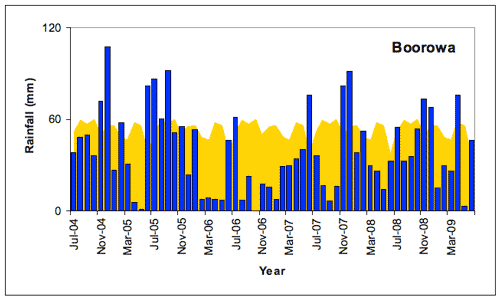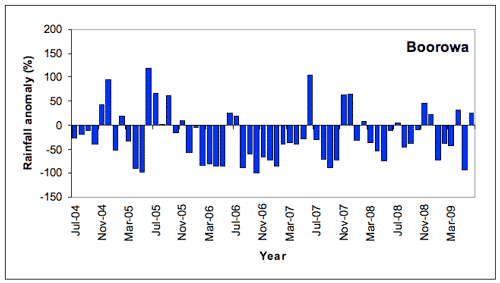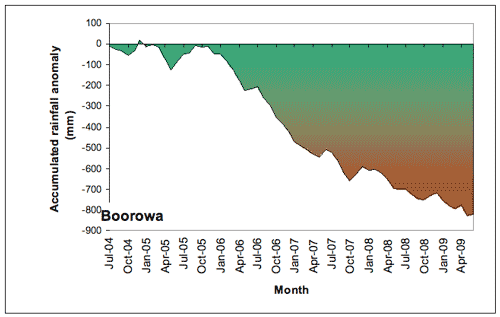Boorowa
Please note: Text or data highlighted in this colour represent an update to this indicator for the period 2008/09. All rainfall figures have been updated on this page.
Rainfall Analysis
The main rainfall observing site used in this analysis was Boorowa Post Office (Bureau of Meteorology Station No. 070220), which has records commencing in 1882. Data from the nearby station at Murringo were used to calculate values for months with missing data at this site (see Appendix 2 for further information).
Note that in the following analyses rainfall totals for individual months or years (where the year is defined as the 12 months from July to June) are compared to the long-term average (or climatology) from 1961-1990. A 30-year period is used to calculate climatological averages to conform with World Meteorological Organisation practice; this takes into account year-to-year variations and less frequent events such as El Niño or La Niña. This particular 30-year period is used internationally as a standard climatological average period.
As shown in the table below, Boorowa was drier than average for all five years in the period 2004/05-2008/09. The driest year was 2006/7, when rainfall was 46.3% below the long-term average at 341.1 mm for the year. This was the third driest Jul-Jun 12 month period since the records at Boorowa began in 1882. The wettest year in the last four years was 2004/05, when rainfall at 554.4 mm was still 12.8% below the average.
Table 1. Annual rainfall statistics at Boorowa, 2004/05-2008/09
| Rainfall Statistics | Boorowa | ||||
|---|---|---|---|---|---|
2004/5 |
2005/6 |
2006/7 |
2007/8 |
2008/9 |
|
| Annual Total* (mm) | 554.4 |
500.2 |
341.4 |
441.4 |
515.0 |
| Anomaly (mm) | -81.6 |
-135.8 |
-294.6 |
-194.6 |
-121.0 |
| Anomaly (%) | -12.8 |
-21.4 |
-46.3 |
-30.6 |
-19.0 |
| Mean (1961-1990) (mm) | 636.0 |
||||
*Note: annual totals were calculated for the 12 months July-June.
Monthly Rainfall, 2004-2009
A comparison of monthly rainfall totals with the long-term monthly average rainfall at Boorowa (Figure 1) shows that most of the period experienced below-average rainfall, with the exception of the period December 2004 to January 2006 and November 2007 and February 2008. Generally dry conditions were experienced between July 2004 and May 2005 with very dry conditions between February 2006 and October 2007 apart from June and July 2006 and June 2007. These very dry conditions reflect the impact of the El Niño event during 2006/7 while the increase in rainfall at the end of 2007 reflects the development of a La Niña event. Dry conditions returned for the period March to June 2008. Rainfall in November-December 2008 was related to another La Niña event.
Figure 1. Boorowa monthly rainfall totals (blue bars) compared with the long-term monthly mean rainfall shown in yellow (all in mm) July 2004-June 2009.

Of the 60 months in this period, 41 months (68% of the record) had below-average rainfall at Boorowa (Figure 2). The most prolonged dry spell began in December 2005 and extended to October 2007. During this period there were only 3 months with above average rainfall and 20 months with below average rainfall, most with extremely dry conditions. The period June 2004 to May 2005 was generally below average apart from 4 months while the period June 2005 to November 2005 was generally above average in rainfall. The period November 2007 to February 2008 was generally above average, however, dry conditions returned for the period March 2008 to June 2009 during which there were only 5 months of average or above average rainfall of which 3 were successive months October 2008-Deember 2008. The driest individual month was October 2006, with 0 mm (the long-term average for October is 60 mm) while only 1 mm was recorded in May 2005 and 3.2 mm in May 2009 (long term average for May is 56.1 mm). The wettest month was December 2004 with 107.6 mm (long term average for December is 55.2 mm).
 |
The result of the generally dry conditions at Boorowa during the period 2004-2009 can be seen in Figure 4 indicating the accumulated rainfall deficit over this period. While the deficit was close to the norm from June 2004 to November 2005, it increased dramatically during 2006/7 and continued to increase until the end of the period. Rainfall deficits occurred in 32 out of the 43 months from December 2005 to June 2009. The total rainfall deficit for the five year period was 821.5 mm (129% of the Jul-Jun average rainfall). These dry conditions reflect the impact of the El Nino event that was experienced during 2006/7 and no compensating wet period since.
 |
The climatological context for rainfall at Boorowa
The long-term perspective
As is typical of the region, Boorowa has experienced large fluctuations in annual (July-June) rainfall, including several extended periods of above- and below-average rainfall since records began in 1882. In general, annual rainfall was lower and less variable early in the 20th century, followed by a period of greater variability. Rainfall variability has been lower since about 1980 (Figure 4). The recent dry period is reflected in other parts of the long term record such as the early part of the 20th Century and the period from the late 1920’s through to the end of World War 2. To this point in time this recent dry period can only be considered as part of the long term variability in rainfall experienced in the region.
- Rainfall in the late 19th and early 20th century was generally below average (to about 1915). The following 20 years was characterised by high variability, after which conditions were dry from the early 1930s to the mid 1940s.
- Several wetter-than-normal years around 1950 and 1960 produced a generally wetter period then.
- A generally drier period around 1980 was followed by variable rainfall until the early 1990s. Since 1997 conditions have been drier than average with a continued prolonged dry period since 2002.
The wettest year (July-June) on record was 1955/56 (1105.4 mm); the driest year was 1896 (255.4 mm).
![Figure 4. Annual (July-June) rainfall at Boorowa from 1882/3 to 2008/9 depicted as deviations from the long-term mean. A 5-year running mean is superimposed to highlight wetter and drier periods. [Deviations were calculated as the difference between the rainfall for each year and the mean for the period 1961-1990 (scale in mm).]](../images/boorowa/rain04.gif) |
Figure 5 shows the impact of the dry period from the year 2000. Rainfall deficits increased considerably during 2002, flattened out during 2003/4 then increased considerably again during 2006/7 and has continued to slowly increase. This reflects the impacts of the two El Niño years of 2002-3 and 2006-7 without a compensating wet period. During the whole period there were 72 months (67%) of rainfall deficit and the total accumulated deficit was 1219.6 mm (192% of the average Jul-Jun rainfall).
 |
About the data
